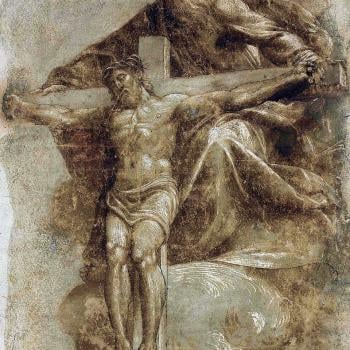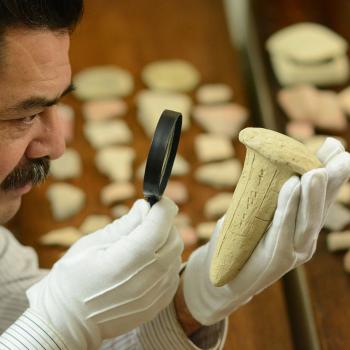
The following blog reflection focuses on whether Jesus’ resurrection was the result of wishful thinking or wish fulfillment on the part of Jesus’ disciples. Let’s begin with brief consideration of C.S. Lewis’ analysis of different ways of viewing Jesus: as lunatic, liar, and Lord, as well as his ensuing engagement of the notion of legend. Whereas Lewis contends that Jesus is not a lunatic, lying demon, or the result of legend, but Lord, so I am arguing that his disciples were not creative enough, courageous enough, or credible enough in terms of faith in the resurrection to have created the doctrine.
In Mere Christianity, Lewis sought to debunk the claim that Jesus was simply a good moral teacher worthy of consideration. It is here that he discusses lunatic, liar, and Lord:
I am trying here to prevent anyone saying the really foolish thing that people often say about Him: I’m ready to accept Jesus as a great moral teacher, but I don’t accept his claim to be God. That is the one thing we must not say. A man who was merely a man and said the sort of things Jesus said would not be a great moral teacher. He would either be a lunatic — on the level with the man who says he is a poached egg — or else he would be the Devil of Hell. You must make your choice. Either this man was, and is, the Son of God, or else a madman or something worse. You can shut him up for a fool, you can spit at him and kill him as a demon or you can fall at his feet and call him Lord and God, but let us not come with any patronizing nonsense about his being a great human teacher. He has not left that open to us. He did not intend to.[1]
Lewis has been criticized for not accounting here in Mere Christianity for another possibility that discredits Jesus’ lordship in addition to lunatic and liar. That alternative possibility is legend, as noted above: legend in this case signifies that the gospel accounts do not reflect the real life history of Jesus. Lewis later addressed the topic of legend in God in the Dock:
Another point is that on that view you would have to regard the accounts of the Man as being legends. Now, as a literary historian, I am perfectly convinced that whatever else the Gospels are they are not legends. I have read a great deal of legend and I am quite clear that they are not the same sort of thing. They are not artistic enough to be legends. From an imaginative point of view they are clumsy, they don’t work up to things properly. Most of the life of Jesus is totally unknown to us, as is the life of anyone else who lived at that time, and no people building up a legend would allow that to be so. Apart from bits of the Platonic dialogues, there is no conversation that I know of in ancient literature like the Fourth Gospel. There is nothing, even in modern literature, until about a hundred years ago when the realistic novel came into existence. In the story of the woman taken in adultery we are told Christ bent down and scribbled in the dust with His finger. Nothing comes of this. No one has ever based any doctrine on it. And the art of inventing little irrelevant details to make an imaginary scene more convincing is a purely modern art. Surely the only explanation of this passage is that the thing really happened? The author put it in simply because he had seen it.[2]
Taking as my transition point Lewis’ discussion of legend where he challenges the notion that the canonical Gospels are legendary creations, I wish to challenge the notion that the canonical Gospel accounts of the resurrection are the result of wishful thinking on the part of the disciples.
In the ensuing discussion, I will consider the disciples’ way of being and how they approached Jesus, as recorded in Scripture. Moreover, I will seek to account for the historical context and backdrop for the doctrine of resurrection, as well as the development of early Christianity. It will be important for the reader to consider the text and footnotes in reflecting upon the four main points of this blog post.* Throughout this article, I make my case that in no way did the disciples engage in wishful thinking in reflecting upon and championing the doctrine of Jesus’ bodily resurrection from the dead. They did not create it. They testified to it.
First, further to Lewis’ point noted above that the canonical Gospel accounts are not legends, since they are not artistic enough, the disciples were not creative enough to engage in wishful thinking that Jesus rose from the dead.[3] The idea that an individual would rise from the dead in an immortal state was off the Jewish radar at their time (surely John’s Gospel details Lazaras’ resurrection in chapter 11, but he would die again).[4] There was a belief in a general resurrection, at least by the Pharisees, but not of a specific individual.[5] How would these particular disciples come up with such a view out of nowhere? It was off the radar, so to speak. The disciples manifested complete cluelessness in grappling with what Jesus said about his resurrection (Refer back to footnote 3).
Second, the disciples were not courageous enough.[6] The idea that Jesus was raised from the dead certainly placed him above Caesar under whom he was crucified.[7] The idea of a resurrected Messianic King and Lord crucified as an enemy of the empire under the Roman governor Pontius Pilate would be a frontal assault on Caesar’s claim to supremacy and would put the target on Jesus’ disciples’ backs. Their religion was a far cry from the claim often attributed to Scientology’s founder L. Ron Hubbard: if you want to get rich, start your own religion.[8] Their religion only got the apostolic community persecution and executions, not comfort and luxury. Their belief was a death wish. According to church tradition, every one of the apostles, except John, was martyred for the faith. And in John’s case, he also suffered greatly.
Third, the disciples were not credible enough when it comes to steadfast faith. That is not to say the disciples lacked moral credibility. They were morally credible, but they were not heroic personalities with superhero faith. Moreover, they were unschooled and ordinary. Their most distinguished and distinguishing quality was that they had been with Jesus, as the Sanhedrin noted, according to Acts 4:13-14. Regarding their lack of superhero faith, the New Testament documents that the disciples struggled to believe in Jesus’ miracles, including the resurrection.[9] As already noted in footnote 3, they even struggled with Jesus’ predictions over his death (Refer as well to Peter’s rebuke of Jesus recorded in Matthew 16:21-23 when Jesus predicts his death). The same goes for the resurrection accounts themselves. They were dumbfounded and filled with disbelief. Take for example Mark 16 (ESV; italics added):
But go, tell his disciples and Peter that he is going before you to Galilee. There you will see him, just as he told you.” And they went out and fled from the tomb, for trembling and astonishment had seized them, and they said nothing to anyone, for they were afraid (Mark 16:7-8).
She went and told those who had been with him, as they mourned and wept. But when they heard that he was alive and had been seen by her, they would not believe it (Mark 16:10-11).
After these things he appeared in another form to two of them, as they were walking into the country. And they went back and told the rest, but they did not believe them (Mark 16:12-13).
The Bible never hides from doubt or portrays Jesus’ disciples in a flattering light.[10] Their lack of credibility as heroic people of faith is itself very credible and realistic. It speaks to the authenticity of the gospel accounts.[11] How many of us today would portray ourselves in such negative light if we were recounting our personal histories? Even if we refused to doctor our personal histories, we might choose to delete unfavorable accounts to safeguard our dignity.
It is worth pausing here to point out that even though the canonical Gospel accounts do not portray the disciples in a favorable light, Jesus is never recorded as demeaning the disciples or attacking their dignity. At times, he rebukes and challenges them, but ultimately, he affirms them, encourages them, and invites them to believe. We see this in the case of Jesus’ encounter with his disciple Thomas after the resurrection (See John 20:24-29). Thomas is on record saying that he would not take the testimony of the other disciples as sufficient for faith. He asserted that he would only believe if Jesus stood before him, and he could place his finger in Jesus’ nail-torn hands and place his hand in Jesus’ spear-pierced side. The painting by Caravaggio shown above in this blog post shows the bodily resurrected Jesus standing before Thomas, taking his hand and placing it in his side. John’s Gospel narrates Jesus inviting Thomas to put his finger in Jesus’ hand and his hand in Jesus’ side. Jesus invites inquisitive minds and hearts, like Thomas, not inquisitional attitudes, like those found among key members of the religious and political establishments in his day. And so, this disciple should be known as the devoted Thomas, not doubting Thomas. John’s Gospel then turns from Thomas to the reader of the gospel account with Jesus’ claim that blessed are those who have not seen, like Thomas has, and yet still believe (See again John 20:24-29). The canonical Gospel accounts, including this story involving Thomas, reveal that there are enough reasons to believe. Reason enough, as much as is needed in a healthy inquisitive manner, to understand and believe. Still, while reason is vitally important, it is not alone sufficient or enough to believe: relational trust, as in the case of Thomas, who inquires openly, inquisitively and devoutly, is also required.
Fourth, the preceding claims are reason enough to keep the conversation going with the seeker regarding the Christian claim that Jesus rose bodily from the dead.[12] As noted above, the disciples were not creative enough, courageous enough, or credible enough to engage in wishful thinking or legend making. To think otherwise is wishful thinking. Moreover, there is more than enough reason to believe Jesus was raised bodily. All too often, the arguments intended to debunk the bodily resurrection accounts of Jesus appear as wishful thinking. More to this point, the claim that the disciples engaged in wishful thinking and legend making cannot make sense of the disciples’ changed state from cowardice and cluelessness to tenacious courage and cogent confidence, or the amazing expansion of the Christian faith in the face of death in the apostolic period.
Further to the point just made on the changed state of the disciples, we close with the following reflection from N.T. Wright, who wrote of two “normal options open to” the disciples following Jesus’ apparent demise in death: they could have chosen to go back to fishing and other former occupations, or they could have chosen a replacement as messiah from among Jesus’ blood relatives, like James. However, they did not go in either direction, but were unswerving in their allegiance to Jesus of Nazareth. Here’s Wright:
We must, then, ask once again: Why did Christianity even begin, let alone continue, as a messianic movement, when its Messiah so obviously not only did not do what a Messiah was supposed to do but suffered a fate which ought to have showed conclusively that he could not possibly have been Israel’s anointed? Why did this group of first-century Jews, who had cherished messianic hopes and focused them on Jesus of Nazareth, not only continue to believe that he was the Messiah despite his execution, but actively announce him as such in the pagan as well as the Jewish world, cheerfully redrawing the picture of messiahship around him but refusing to abandon it? Their answer, consistently throughout the evidence we possess, was that Jesus, following his execution on a charge of being a would-be Messiah, had been raised from the dead.[13]
_______________
[1]C.S. Lewis, Mere Christianity (New York: HarperCollins Publishers, 1952/1980), page 53.
[2]C.S. Lewis, God in the Dock: Essays in Theology and Ethics, ed. Walter Hooper (Grand Rapids: Eerdmans, 1970), page 169.
*I am grateful to my colleague Derrick Peterson for his scholarly assistance with various references and reflections in several of the footnotes that supplement my argument throughout this blog article.
[3]It is interesting to note that the disciples consistently fail to understand Jesus’ message about death and resurrection before the event itself. Take for example the following text from Luke’s Gospel: “And taking the twelve, he said to them, ‘See, we are going up to Jerusalem, and everything that is written about the Son of Man by the prophets will be accomplished. For he will be delivered over to the Gentiles and will be mocked and shamefully treated and spit upon. And after flogging him, they will kill him, and on the third day he will rise.’ But they understood none of these things. This saying was hidden from them, and they did not grasp what was said” (Luke 18:31-34; ESV; italics added). Though it was certainly not without precedent, the resurrection of the dead was not a huge main focus at their time. To say that the resurrection was merely wish-fulfillment on the part of the disciples is to raise a whole series of questions about where this idea came from and how it would have been justified. The primary hope in Judaism was that the seed of Abraham would continue its line and flourish. On this, see Walther Zimmerli, Man and His Hope in the Old Testament (New York: Hymns Ancient and Modern, 2012 reprint).
[4]On the post-Old Testament context for post-death hope, see: N.T. Wright, The Resurrection of the Son of God (Minneapolis, MN: Fortress Press, 2003), pages 129-207.
[5]This point is emphasized by Wolfhart Pannenberg, Jesus: God and Man 2nd ed., trans. Lewis L. Wilkins and Duane A. Priebe (Philadelphia: The Westminster Press, 1977), pages 66-106. The point here is a subtle one that is attempting to account for both continuity and difference. In terms of continuity, the resurrection of the body was not a new concept per se, though its exact form varied. It was not therefore a wholesale new notion or discover. On the other hand, the specific form the resurrection took in the resurrection of the single person, Jesus, was different enough from the expectation for general resurrection that it would be incredible if one were to dismiss it as wish-fulfillment. William Lane Craig writes of the uniqueness of the New Testament conception of the resurrection in relation to the Jewish backdrop: “But the Jewish conception of resurrection differed in two important, fundamental respects from Jesus’ resurrection. In Jewish thought the resurrection always (1) occurred after the end of the world, not within history, and (2) concerned all the people, not just an isolated individual. In contradistinction to this, Jesus’ resurrection was both within history and of one individual person.” Craig also accounts for scholarship detailing the singular uniqueness of the New Testament conception of the resurrection: the resurrection of the righteous to glory is dependent on this one Messianic individual (See 1 Corinthians 15:20). William Lane Craig, “Contemporary Scholarship and the Historical Evidence for the Resurrection of Jesus Christ,” in Truth, 1 (1985): 89-95. Republished at the CS Lewis Society of California: https://www.lewissociety.org/resurrection/ (accessed on 4/21/2019).
[6]On the other hand, given the level of distress recorded in the Scriptures over Jesus’ death, the “cognitive dissonance” theory has also been posed. Here it is argued that it was not an act of courage but an act of extreme trauma and psychological defense that led the disciples to invent the story of Christ’s resurrection. This, however, again runs into the problem pointed out above that the resurrection of Jesus was not what was expected within the horizon of second-Temple Judaism. See Wright, Resurrection, pages 697-701.
[7]While the anti-imperial context can be overplayed, it is nonetheless a serious aspect that needs to be considered. See the thoughtful and balanced essays in Scot McKnight and Joseph B. Modica, ed., with a foreword by Andy Crouch, Jesus is Lord, Cesar is Not: Evaluating Empire in New Testament Studies (Downers Grove, IL: IVP Academic, 2013).
[8]This is particularly important as the rise of the extreme interpretation known as “Jesus Mythicism” has, quite peculiarly, been on the rise as of late. As already noted, C.S. Lewis posed his “trilemma”: Jesus was either a Lord, a Liar, or a Lunatic. To this, the mythicists add “Legend” and revive the moldy claims of the history of religions school and argue that Jesus did not even exist but was rather a figure invented by combining a hodgepodge of ancient myths and legends for the political purposes of the disciples. In addition to having already accounted for Lewis’ take on legends, it is notable that even the skeptical textual critic Bart Ehrman sees the “Jesus Legend” folks as the Jesus studies equivalent of flat earthers. See Bart Ehrman, Did Jesus Exist? The Historical Argument for Jesus of Nazareth (New York: HarperOne, 2012). For a thorough examination of the variety of auxiliary claims related to the Jesus Legend group, and arguments against them, see the important work of Paul Rhodes Eddy and Gregory A. Boyd, The Jesus Legend: A Case for the Historical Reliability of the Synoptic Jesus Tradition (Grand Rapids: Baker Academic, 2007). William Lane Craig references distinguished historian of Roman and Greek sources, A.N. Sherwin-White, who chastises those New Testament scholars who discount the vital importance of the New Testament for the historical reconstruction of the events they recount. White points out that far more time (more generations) would have been needed for legends to be created whereby the historical is replaced by the unhistorical. As Craig notes, “All NT scholars agree that the gospels were written down and circulated within the first generation, during the lifetime of the eyewitnesses.” See again: Craig, “Contemporary Scholarship and the Historical Evidence for the Resurrection of Jesus Christ.”
[9]One of the most common arguments against the resurrection is to leverage the more general naturalist position against miracles in general, and to appeal to the “credulous” nature of non-modern belief. This, however, forms its own counter-faith that holds on in spite of all evidence to the contrary. Here it is important to note that, like clockwork, the disciples either do not believe or do not understand the miracles of Christ. They were hardly gullible in buying hook, line and sinker everything they heard and experienced. Furthermore, as C.S. Lewis and others have pointed out, the identification of a “miracle” in fact presupposed an understanding of the normal courses of nature.
[10]For all the historiographical issues that go into the interpretation and validation of the claim that Jesus rose from the dead, see the groundbreaking work of Michael R. Licona, The Resurrection of Jesus: A New Historiographical Approach (Downers Grove, IL: IVP Academic, 2010).
[11]For a good place to start on the reliability of the Gospels, see Craig L. Blomberg, Can We Still Believe the Bible? An Evangelical Engagement with Contemporary Questions (Grand Rapids: Brazos Press, 2014). In regard to the events surrounding the resurrection and historical inquiry, Gary Habermas has produced what he terms his “minimal facts” argument that puts forward five basic points that are nearly unanimously acknowledged by scholars regardless of whether they themselves are believers or not. See: Gary R. Habermas and Michael R. Licona, The Case for the Resurrection of Jesus (Grand Rapids: Kregel Publications, 2004).
[12]For a good book that shows a dialogue between a believer and an atheist on the resurrection, see Gary Habermas and Antony Flew, Did the Resurrection Happen? A Conversation with Gary Habermas and Antony Flew (Illinois: IVP Academic, 2009). See also the book by Clark H. Pinnock titled Reason Enough: A Case for the Christian Faith (Eugene: Wipf & Stock, 1997). There he puts forth various arguments in seeking to make a well-reasoned and wide-ranging case for the sufficiency of the Christian faith’s truth claims.
[13]N.T. Wright, “Christian Origins and the Resurrection of Jesus: The Resurrection of Jesus as a Historical Problem,” in Sewanee Theological Review, 41.2, 1998, reproduced by permission of the author at http://ntwrightpage.com/2016/07/12/christian-origins-and-the-resurrection-of-jesus-the-resurrection-of-jesus-as-a-historical-problem/ (accessed on 4/21/2019).












